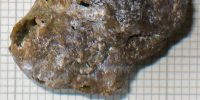

Introduction ('Home')
Thermal Imaging Photographs
Woodpile and Ash Pits
Covering the Pot Furnace
Photographs of Pots
Photographs of Glass Waste
Photographs of Glass Vessels
The waste glass has been recovered from ash which was removed as charcoal and ash from the furnaces on a daily basis.
It invariably has a matt surface and falls into several categories:
 formed from small chunks of cullet which have shattered on introduction into the furnaces to fill the
pots (and tank). They have scattered and fallen into the hot ash and charcoal in the firing chambers,
where they have remelted to form small globules.
formed from small chunks of cullet which have shattered on introduction into the furnaces to fill the
pots (and tank). They have scattered and fallen into the hot ash and charcoal in the firing chambers,
where they have remelted to form small globules.
 formed from small rivulets of glass which have dripped from ledges and walls inside the furnace. Possibly also formed from glass moving downwards between fragments of charcoal or through small empty spaces in the charcoal and ash. They are often twisted and distorted, possibly due to disturbance when the charcoal is raked out.
formed from small rivulets of glass which have dripped from ledges and walls inside the furnace. Possibly also formed from glass moving downwards between fragments of charcoal or through small empty spaces in the charcoal and ash. They are often twisted and distorted, possibly due to disturbance when the charcoal is raked out.
 formed over a length of time from drips or rivulets of molten glass originating from either large chunks
of glass falling onto the pot shelf or from small leaks or overflows in the pots. The most extreme example
of this is from one pot which developed a large crack and emptied over a short period of time (perhaps a
night or a day). These larger lumps often mould themselves around small pieces of charcoal which are
sometimes still embedded in the glass. When the charcoal is removed, the elongated and distorted fingers of
glass are visible.
formed over a length of time from drips or rivulets of molten glass originating from either large chunks
of glass falling onto the pot shelf or from small leaks or overflows in the pots. The most extreme example
of this is from one pot which developed a large crack and emptied over a short period of time (perhaps a
night or a day). These larger lumps often mould themselves around small pieces of charcoal which are
sometimes still embedded in the glass. When the charcoal is removed, the elongated and distorted fingers of
glass are visible.
 changed on the surface due to prolonged contact with the ash. This appears to vary according to the
length of time of exposure to the hot ash, and varies from a change in the surface colour to grey or
brown to a possible full-blown combining of the glass with the ash to form a new glass with inclusions on
the surface. This is awaiting verification from analyses of glass samples.
changed on the surface due to prolonged contact with the ash. This appears to vary according to the
length of time of exposure to the hot ash, and varies from a change in the surface colour to grey or
brown to a possible full-blown combining of the glass with the ash to form a new glass with inclusions on
the surface. This is awaiting verification from analyses of glass samples.

|

|

|
"If you build it, they will come."